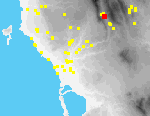 A03
Metaxada Kalopsana (3)
A03
Metaxada Kalopsana (3)
Tile: HL-Byz
contiguous: (EH II)
A small raised knoll - about 45 m. long and 20 m. wide - lies ca. 2 km S of Metaxada village at the SW end of a low ridge extending from the E side of the Metaxada valley[091.25]. Vineyards lie to its W and S, and weedy fields to the N and E; there are occasional olive trees planted in the vicinity. High maquis and fully grown trees cover most of the feature, the more open W end of which is marked by a horseshoe-shaped cavity. Substantial parts of it, on its NW and S[091.23] sides, have been bulldozed to expand the surrounding fields.
Fragments of tile, human bone, and a very little pottery were discovered in several discrete locations in the scarps exposed and at their base. The four loci (#2-5) with associated material were all located on the NW side of the knoll. Fragments of human bone were recovered from one of these (Locus 2), as was a small Roman glass vessel. Locus 1, located at the SW corner of the knoll, was a stone-filled pit, but no artifacts were obviously associated with it. 10-12 long, flat slabs were visible in the S scarp, on top of the knoll, and to its N and W. Small, unworked stones and tile fragments are common in addition to the slabs.
Revisitation in 1995 revealed artifacts similar to those collected in 1992 in the eroding scarps of the knoll and in the fields at its base.
This site contained ceramics collected from disturbed graves and a tile pile. Diagnostic pottery dates to Dark Age-Geometric, Roman and Byzantine periods. The collected pottery is primarily from Roman-Byzantine cookware vessels.